A small and faint constellation of the southern sky, situated about 35 degrees below the head of Hydra, between the Antila and the Puppis. The brightest stars of the constellation Pyxis α (3.68mag), β (3.97mag) and γ Pyxidis (4.01mag) lie almost in a straight line. The constellation is poor for observers with a binocular or small telescope, but there are a few fainter open clusters, galaxies and planetary nebulae.
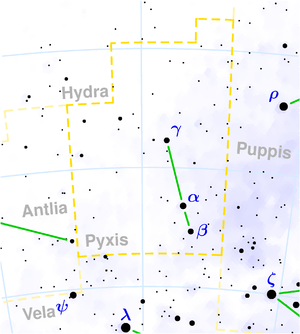
α Pyx - The brightest star in the constellation has an apparent magnitude of 3.7. It is located 470 light-years away.
β Pyx - The yellow supergiant of spectral class G5. A companion with a brightness of 12.5mag is located at an angular distance of 12.6".
κ Pyx - A binary star, with a companion of 10th magnitude, is located at a separation of 2.1 arcseconds from the component with a brightness of 4.8 magnitude. We will need a telescope with an objective diameter of at least 150 mm.
ζ Pyx - The main component has a brightness of 5.5 mag and its companion has a brightness of 10 mag at a distance of 52.3". We can distinguish them with a telescope with an 8 cm diameter objective.
ε Pyx - A remarkable multiple star. The primary component has a brightness of 5.6 mag and at a separation of 17.8", it can be observed with a telescope with a 60 mm objective diameter as a guide star with a brightness of 9.2 mag. With a larger telescope, we can also observe a star of magnitude 10 at a separation of 0.3".
T Pyxidis - One of the most famous objects in the constellation, a recurrent nova with a minimum magnitude of 16. During unexpected outbursts that occur every 12 to 25 years, its brightness increases to 6-7 magnitude. Such outbursts were recorded in 1890, 1902, 1920, 1944, and 1966.
NGC 2818
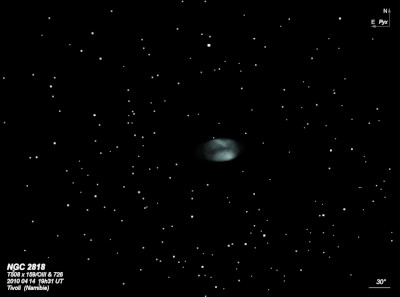
13.1 (1/28/84): the cluster is a faint group of two dozen stars mag 12 and fainter. The planetary on the west side of the cluster is a pretty sight using a UHC filiter at 79x. It appeared fairly faint, moderately large, 1.0'x0.8', elongated N-S or SSW-NNE.
The planetary had been assumed to be the only one to be physically associated with an open cluster, although recent research firmly places the planetary in the foreground.
James Dunlop discovered NGC 2818 = D 564 = h3154 on May 28 1826 and recorded a "pretty large faint nebula [star cluster] of a round figure, 6' or 8' diameter; the nebulosity is faintly diffused to a considerable extent. There is a small nebula [PN] in the north preceding edge, which is probably a condensation of the faint diffused nebulous matter; The large nebula is resolvable into stars with small nebula remaining." His position is 15' southwest of the planetary.
John Herschel recorded on 7 Aug 1837 (sweep 787): "A very curious object which reminds me strongly of M46 and IV. 39 [NGC 2438]. It is a rich cluster of the VI class, stars 12..14m; about 8' dia, gpmbM; all but a sort of vacuity, in which is situated a pB, R, neb; 40" diam; of a character approaching to planetary, having its edges shading off very rapidly, and being but very little brighter in the middle." His sketch is reproduced on plate V, figure 8 of the CGH Observations. A second observation on 22 Jan 1838 (sweep 809) describes the planetary first and the NGC summary refers to the planetary (in a large cluster). So the number NGC 2818 could apply to the planetary or the cluster. RNGC lists the cluster as NGC 2818 and the planetary as NGC 2818A.
Joseph Turner (date uncertain) and Pietro Baracchi (15 Jan 1885) sketched NGC 2818 with the Great Melbourne Telescope (unpublished Plate VI, figure 65).
300/350mm - 13.1" (4/10/86): the cluster appears as a faint group of 25-30 stars mag 12 to 15, over unresolved haze, though good seeing might resolve more. Includes a fairly faint planetary (NGC 2818A) on the west side. At 166x using a Daystar 300 filter, the planetary appeared moderately bright and large, elongated ~N-S. Also responds well to an OIII filter at 79x.
400/500mm - 17.5" (3/25/00): NGC 2818 refers to both an open cluster and a superimposed planetary nebula (identified as NGC 2818A in the RNGC). The moderately bright PN is nestled on the west side of a faint but fairly rich open cluster. At 220x it appeared moderately bright, irregularly shaped, ~1.0'x0.8' and elongated roughly N-S. Excellent view at 280x with a UHC filter and unfiltered at 380x. The rim is irregularly brighter and gave a weak annular appearance; brightest at the south and southwest rim. The center is slightly darker but there was no well-defined central hole. The outline is not crisp and seemed to change orientation somewhat with averted vision.
Notes by Steve Gottlieb
NGC 2627
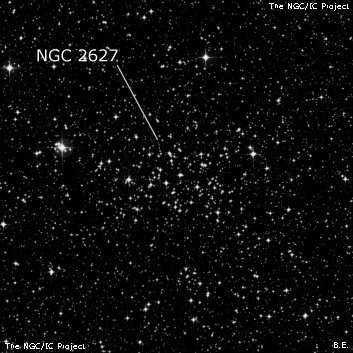
William Herschel discovered NGC 2627 = H VII-63 = h516 = h3132 on 3 Mar 1793 (sweep 1032) and described "a large cluster of scattered small stars, irr F, considerably rich." John Herschel observed the cluster from both England and the Cape of Good Hope, where he recorded "a fine, L, rich, pretty much compressed cluster; irregularly E, 10' l, 7' br; stars 12 and 13th mag nearly equal."
300/350mm - 13.1" (1/18/85): about 45 stars mag 11-14 in a 10' region elongated E-W. This is a rich and pretty cluster set over an unresolved background haze. Located 40' SW of a mag 5 star. Visible in a 16x80 finder.
Notes by Steve Gottlieb
NGC 2658
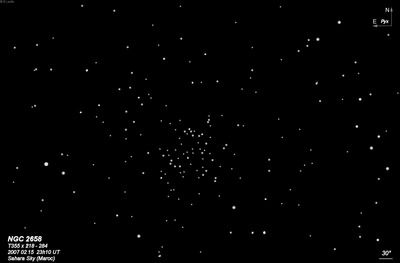
James Dunlop discovered NGC 2658 = D 609 = h4017 on 28 May 1826 and described a "small round faint nebula. North of L. Pyxidis". His position is just 3.3' southwest of center (relatively accurate for his positions), so the identication is fairly secure. John Herschel recorded the cluster on 16 Feb 1836 and noted a "Cl class 8; not m comp; not v rich; v irreg fig; 5' diam; st 12.13m." He added the cluster in a supplementary list at the end of the Cape catalogue (h4016 to h4021). Dreyer identified these objects as "h o n" (John Herschel Omitted Object) in the NGC.
300/350mm - 13.1" (2/25/84): 10 stars mag 11-14 resolved over haze in a 7' diameter. A knot or double star is at the north edge. Three mag 11 stars are off the south, southeast and east side but the remaining stars are mag 13-14. Alpha Pyxidis (V = 3.7) lies 35' SSE.
Notes by Steve Gottlieb
NGC 2613
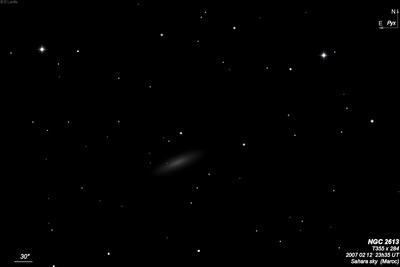
William Herschel discovered NGC 2613 = H II-266 = h3129 on 20 Nov 1784 (sweep 326) and logged "F, E, bM, r, pS that is about 1.5' diameter." On 20 Nov 1784 (sweep 663) he noted "cB, cL, irr F, E nearly in the parallel." John Herschel made 3 observations from the Cape of Good Hope, describing it on one sweep as "B, L, vmE in position 110.3°, pslbM, 3' long, 20" broad." Joseph Turner made a sketch on 18 Jan 1877 with the Great Melbourne Telescope. The galaxy is shown as a thin edge-on with a small bright nucleus.
300/350mm - 13.1" (3/24/84): fairly bright, fairly large, very pretty edge-on 4:1 WNW-ESE, 4.0'x1.0', broadly concentrated. Several stars are nearby as the galaxy is located in a rich star field including a mag 12 star 1.5' N, a mag 13 star 2.0' S of center and another mag 12 star at the west edge of the halo. NGC 2613 is the brightest galaxy in Pyxis.
Notes by Steve Gottlieb
NGC 2663
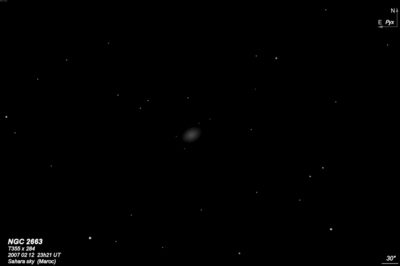
Lewis Swift discovered NGC 2663 = Sw. III-40 on 8 Feb 1886 with the 16" refractor at Warner Observatory in New York. His position is 2.6' south of ESO 371-014. This is probably the brightest galaxy (V = 10.9) discovered by Swift and the most southerly!
400/500mm - 17.5" (3/12/94): fairly faint, moderately large, elongated 3:2 WNW-ESE, 2.2'x1.5', contains a prominent core which is evenly concentrated down to a non-stellar nucleus. Located in rich star field. Several stars are within 5' including a mag 14 star 1.2' N of center and a mag 11.5 star 3.8' NW of center. Located 5.7' NE of a mag 10.5 star.
Notes by Steve Gottlieb
NGC 2635
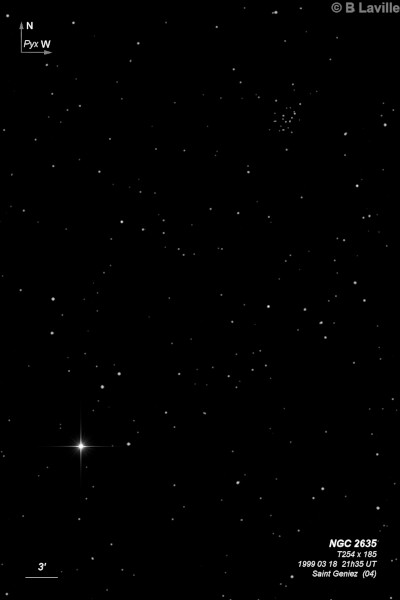
John Herschel discovered NGC 2635 = h3133 on 2 Feb 1835 and recorded "a pretty compressed cluster of st; irregular triangular fig; much more compressed than milky way around it; stars 13 mag." His position is north of the most richest section of the cluster.
300/350mm - 13.1" (2/25/84): small, very mottled cluster at 166x but only a few stars are resolved on the west side. Located 38' NW of Beta Pyxis (V = 4.0).
Notes by Steve Gottlieb
NGC 2883
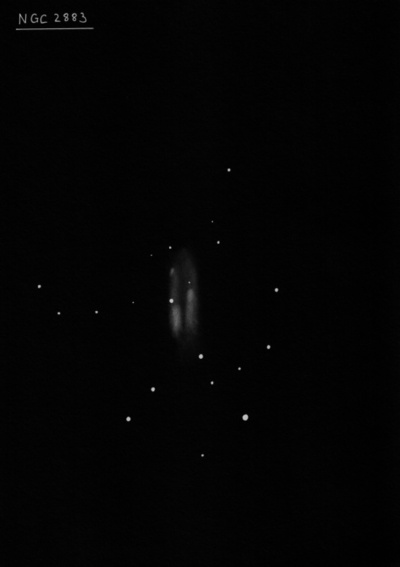
John Herschel discovered NGC 2883 = h3164 on 7 Apr 1837 and recorded "a vF, S, cluster, class VI; vglbM; resolved so as to see the stars which are 15th mag; almost to be called a vF, large nebula." His position matches ESO 372-024 = PGC 26713 and his description matches the superimposed and nearby stars. MCG misidentifies MCG -06-21-006 as NGC 2883 instead of MCG -06-21-005.
400/500mm - 18" (3/11/07): faint, moderately large, elongated at least 2:1 ~N-S, 1.1'x0.5'. Unusual appearance as the galaxy has an irregular, mottled appearance and perhaps three faint stars are superimposed (with several others nearby).
Notes by Steve Gottlieb
M 3-6
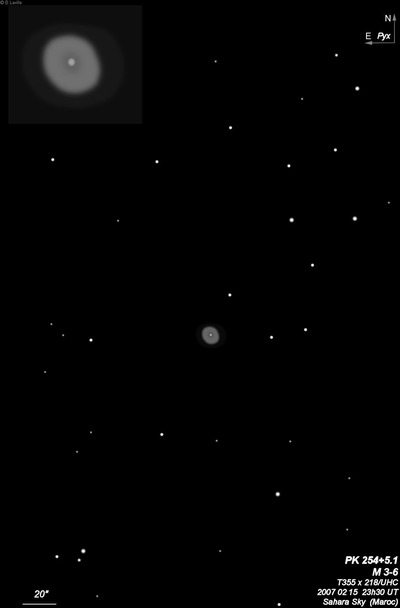
| Type | PN [2a] |
| RA | 08:40:40.2 |
| Dec | -32:22:34.0 |
| major_axis | 18.0'' |
| mag | 11.0 |
| surface_bright | 8.2 |
Abell 29
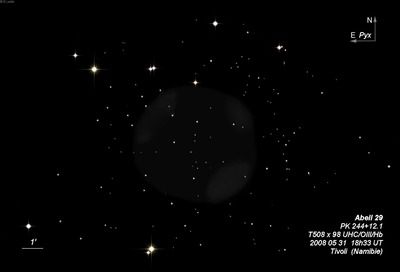
| Type | PN |
| RA | 08:40:18.9 |
| Dec | -20:54:36.0 |
| major_axis | 8.0' |
| mag | 14.3 |
| surface_bright | 18.2 |
Abell 27
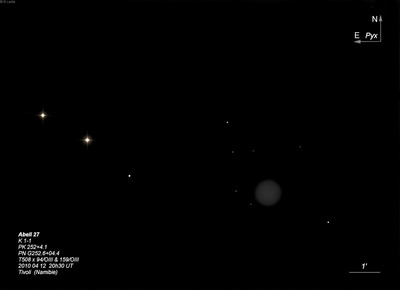
| Type | PN [3b] |
| RA | 08:31:52.6 |
| Dec | -32:06:09.0 |
| major_axis | 60.0'' |
| mag | 17.9 |
| surface_bright | 17.6 |